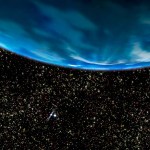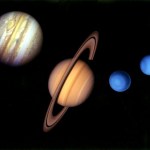Exoplanets
The Milky Way panorama by European Southern Observatory
Steinn Sigurðsson recently spent a weekend considering exoplanets and extraterrestrials at the Second SETI Conference in California. He writes, "It is important to remember that while science and discovery is important, it is not the ontological basis for space exploration. Space is, ultimately, about existential motivations." In other words, we wouldn't mind finding a friend, or a new Earth to colonize when this one gets fried by the sun. As Kepler continues to increase the number of known…
time for all new linkedy links here at the new digs
Quantum Frontiers - a new blog from the Institute for Quantum Information and Matter, with kickoff by John Preskill hisself.
Question of the day: explain quantum mechanics in five words
My attempt: Probability Amplitudes, Observables don't Commute
Good to know John still does khakis and chalk, but we gots to know: does he still have the diet pepsi?
Took me years to break the habit... not that I was overly impressionable as a tender young grad turkey taking QFT or anything.
Subtleties of the Crappy Job Market - for Scientists, that is.…
Why do we need to spend any more effort on extra-solar planets?
We found some, they're there. Lumps of rocks, gasballs. We're done, right?
This, loosely paraphrased, was a serious question I got last week.
The context was a question of why I was spending serious effort on exoplanet research, rather than focusing exclusively on other subfields.
I've heard similar comments from physicists, some particle physicists are notoriously focused in their consideration of what counts as "real physics", but this came from an astronomer; and one that I know does stars, inside the galaxy, sometimes, not…
"Some prophecies are self-fulfilling
But I've had to work for all of mine
Better times will come to me, God willing
Cause I can't leave this world behind" -Josh Ritter
You sure can't leave this world behind. At least, not very easily. The reason for it, of course, is gravity.
Image Credit: Physclips, via the University of New South Wales' School of Physics.
Here on the surface of the Earth, the gravitational potential well is pretty large; large enough that there's no easy way off. Sure, you can pour a huge amount of energy into a rocket to try and overcome this gravitational potential…
"I went into a clothing store, and the lady asked me what size I was. I said, 'Actual'. I'm not to scale." -Demitri Martin
When you look out at the Universe, what you can see is limited, at the most fundamental level, by the size of what you look with. This is why you can see dimmer objects at night -- when your pupils are dilated -- than you can when your pupils are constricted.
Image credit: National Institute of Health.
This same principle that applies to your eyes applies to telescopes as well. As telescopes have grown in size, so has our ability to see deeper into the Universe, as…
When the stars align, the results can be nothing short of spectacular. On Starts With a Bang, Ethan Siegel shows us an "Einstein ring" photographed by the Hubble Space Telescope. This celestial halo surrounds a massive red galaxy, and is in fact light from a much more distant galaxy focused by gravity. Ethan explains, "gravity will bend spacetime, forcing light into a curved path. If a very distant galaxy is properly lined-up with us and a less distant—but very massive—galaxy, its light will not only be bent into a ring if the alignment is perfect, but its light will be greatly magnified…
The planet-hunting spacecraft known as Kepler has detected the first definitive exoplanet in a binary star system, and lead author Dr. Laurance Doyle has all the details on Life at the SETI Institute. He writes, "Perhaps half the stars in the galaxy are in double star systems. Understanding that planets can form in close binary systems means that these, too, can be targets in the search for habitable worlds." The twin stars have a combined mass less than that of our sun—and the planet is the size of Saturn, in an orbit as close as Venus. Fellow SETI Astronomer Dr. Franck Marchis writes, "…
Greg Laden draws our attention to an object named Vesta, which by itself makes up 9% of the asteroid belt. Greg says "if you take the largest handful of objects in the asteroid belt, Ceres, Vesta, Pallas and 10 Hygiea, you've got half of the mass of the entire thing, according to the most current estimates." According to NASA, Vesta is even differentiated, meaning it was once hot enough to form a core, mantle, and crust. On Life at the SETI Institute, the Analysis Lead on NASA's Kepler project explains how to spot a planet from hundreds of millions of miles away. Dr. Jon Jenkins says "We…
On Life at the SETI Institute, Dr. Franck Marchis shares the latest results from Kepler, a telescope in an Earth-trailing heliocentric orbit which keeps a distant eye on 156,453 stars. Kepler watches for tell-tale reductions in brightness, which "could be due to the transit of an exoplanet passing between its star and us." As of Tuesday, Kepler has identified 1202 likely new exoplanets, tripling the number of known worlds beyond our solar system. These results suggest that out of the 200 billion stars in our galaxy, "several hundred million of them could have an exoplanet with a surface…
Many years ago, as I was writing up my thesis, my advisor burst into my office with the hot news.
Someone had announced a possible discovery of an extrasolar planet!
It seems strange now, but back then we really did not know if there were any other planets around other stars.
A lot of astronomers thought that it was quite likely that there were planets around other stars, maybe even most stars, but we had no data.
We were getting there, there were astrometric and radial velocity searches underway, with people like Walker, Griffin and Latham developing techniques which would clearly,…
I'm always happy to receive questions from those of you interested enough to ask them, and every once in a while one of them feels just right to write up an article about it. Today's comes from Brad Walker, who asks about the inside of gas giants. Specifically,
The question pertains to the insides of gas giants like Jupiter... My question is, supposing Jupiter is made of Metallic Hydrogen, and it was dragged close enough to the sun that its atmosphere evaporated, what would be left? How would it go from a very strange non-terrestrial core to a rocky body like CoRoT-7b? Why wouldn't the…



